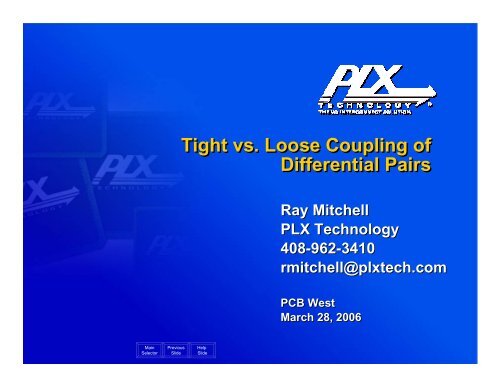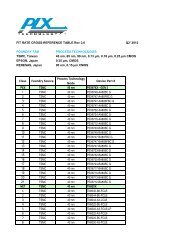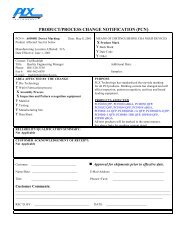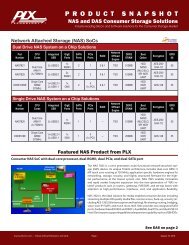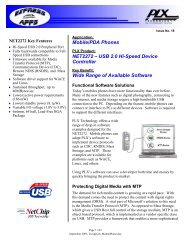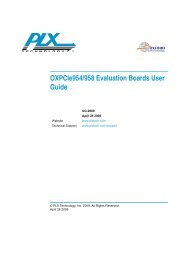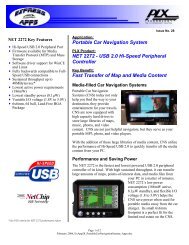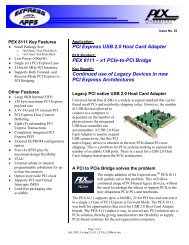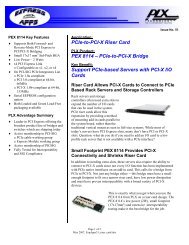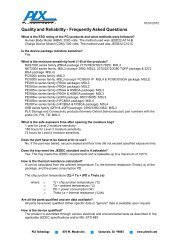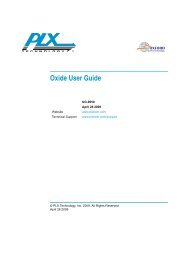Tight vs. Loose Coupling of Differential Pairs for ... - PLX Technology
Tight vs. Loose Coupling of Differential Pairs for ... - PLX Technology
Tight vs. Loose Coupling of Differential Pairs for ... - PLX Technology
Create successful ePaper yourself
Turn your PDF publications into a flip-book with our unique Google optimized e-Paper software.
<strong>Tight</strong> <strong>vs</strong>. <strong>Loose</strong> <strong>Coupling</strong> <strong>of</strong><br />
<strong>Differential</strong> <strong>Pairs</strong><br />
Ray Mitchell<br />
<strong>PLX</strong> <strong>Technology</strong><br />
408-962-3410<br />
rmitchell@plxtech.com<br />
PCB West<br />
March 28, 2006<br />
Main<br />
Selector<br />
Previous<br />
Slide<br />
Help<br />
Slide
Outline<br />
‣ Review <strong>of</strong> differential pair properties and how they differ<br />
between tightly and loosely coupled pairs.<br />
‣ Description <strong>of</strong> test set-up used to look at signal integrity<br />
through several different differential pair architectures.<br />
‣ Results and Conclusions.<br />
‣ Q and A<br />
Main<br />
Selector<br />
Previous<br />
Slide<br />
PCB West 2006
Definitions<br />
For the purposes <strong>of</strong> this talk . . .<br />
‣ “<strong>Tight</strong>ly Coupled” refers to differential pairs that have on<br />
the order <strong>of</strong> 2% crosstalk or more. A typical<br />
configuration could be 5 mil trace width, 5 mil edge-toedge<br />
spacing.<br />
‣ “<strong>Loose</strong>ly Coupled” refers to pairs that have very little<br />
crosstalk. A typical configuration could be 5 mil trace<br />
width, 15 mil edge-to-edge spacing.<br />
Main<br />
Selector<br />
Previous<br />
Slide<br />
PCB West 2006
Properties <strong>of</strong> <strong>Differential</strong> <strong>Pairs</strong> When Used In Cables<br />
‣ <strong>Differential</strong> pairs are used in twisted pair cable<br />
assemblies to interconnect systems whose references,<br />
typically ground, are not the same.<br />
‣ Signal swing within each half <strong>of</strong> the pair at the receiver<br />
can be quite small.<br />
‣ The 2 halves <strong>of</strong> a twisted pair mutually couple so that<br />
outside interference appears equally on both halves <strong>of</strong><br />
the pair and will be rejected at the receiver.<br />
‣ EMI generation is greatly reduced.<br />
‣ It is relatively easy to manufacture twisted pair to make<br />
within pair skew small and impedance constant.<br />
Main<br />
Selector<br />
Previous<br />
Slide<br />
PCB West 2006
Properties <strong>of</strong> <strong>Differential</strong> <strong>Pairs</strong> When Used on PCBs<br />
‣ Effects <strong>of</strong> voltage noise and ground bounce between<br />
driver and receiver can be mitigated. This becomes<br />
more important as edge rates increase and higher<br />
frequencies appear on the power distribution system.<br />
‣ Signal swing within each half <strong>of</strong> the pair at the receiver<br />
can be quite small. This can be important because<br />
glass-epoxy board material can be quite lossy at high<br />
frequencies.<br />
‣ Cross-coupling between two halves <strong>of</strong> a pair is typically<br />
quite small, even <strong>for</strong> 5 mil edge-to-edge spacing. Also,<br />
many current high speed board designs place copper<br />
plane layers next to signal layers which further isolates<br />
the two halves <strong>of</strong> a pair from each other.<br />
Main<br />
Selector<br />
Previous<br />
Slide<br />
PCB West 2006
Properties <strong>of</strong> <strong>Differential</strong> <strong>Pairs</strong> When Used on<br />
PCBs (cont.)<br />
‣ <strong>Tight</strong> coupling reduces the voltage swing <strong>of</strong> the<br />
individual signals within a pair.<br />
‣ EMI generation is greatly reduced by coupling to an<br />
adjacent plane.<br />
‣ Matching trace lengths can be layout intensive.<br />
Main<br />
Selector<br />
Previous<br />
Slide<br />
PCB West 2006
Comparison <strong>of</strong> <strong>Tight</strong> <strong>vs</strong>. <strong>Loose</strong> <strong>Pairs</strong><br />
<strong>Tight</strong>ly Coupled<br />
‣ Each segment <strong>of</strong> a pair must<br />
have very little skew, and the<br />
total flight time must have very<br />
little skew.<br />
‣ If via’ing to other planes, both<br />
halves <strong>of</strong> the pair must<br />
transition at the same place.<br />
‣ Often must use serpentine<br />
traces near the driver to<br />
reduce skew.<br />
‣ <strong>Differential</strong> impedance can<br />
change when routing to<br />
connectors/components.<br />
<strong>Loose</strong>ly Coupled<br />
‣ Each half <strong>of</strong> the pair must<br />
have the same total flight time<br />
to reduce skew.<br />
‣ Each half <strong>of</strong> the pair can be<br />
designed as a 50 ohm<br />
transmission line. This can be<br />
maintained when routing to<br />
connectors/components.<br />
‣ Board layout/fabrication must<br />
provide consistent impedance<br />
and propagation delay across<br />
the area <strong>of</strong> the board.<br />
Main<br />
Selector<br />
Previous<br />
Slide<br />
PCB West 2006
Image Current in the Adjacent Plane Provides the<br />
Return Current<br />
‣ Assume a plane separated<br />
from a signal layer by 3.5 mil.<br />
‣ Return current will want to flow<br />
along the same X-Y path as<br />
the signal.<br />
‣ If it is prevented from doing<br />
so, it may be difficult to<br />
determine the route it does<br />
take.<br />
‣ This will cause impedance<br />
discontinuities and differential<br />
mode noise.<br />
Main<br />
Selector<br />
Previous<br />
Slide<br />
PCB West 2006
Trying to See the Difference<br />
Between <strong>Tight</strong> and <strong>Loose</strong><br />
<strong>Differential</strong> <strong>Pairs</strong><br />
Main<br />
Selector<br />
Previous<br />
Slide<br />
Help<br />
Slide
Test Set-Up<br />
Main<br />
Selector<br />
Previous<br />
Slide<br />
PCB West 2006
Test Board <strong>Differential</strong> <strong>Pairs</strong><br />
‣ <strong>Loose</strong> <strong>Coupling</strong> – 100 mil edge-edge separation.<br />
‣ <strong>Tight</strong> <strong>Coupling</strong> – 7 mil edge-edge separation.<br />
‣ Broadside <strong>Differential</strong> Pair.<br />
‣ Via mismatch pairs. 1 inch separation.<br />
‣ Aggressor traces – 7 mil edge-edge separation from<br />
one half <strong>of</strong> a pair.<br />
‣ All traces are 12 inch total length.<br />
Main<br />
Selector<br />
Previous<br />
Slide<br />
PCB West 2006
<strong>Tight</strong> and <strong>Loose</strong> <strong>Coupling</strong> <strong>Pairs</strong><br />
Main<br />
Selector<br />
Previous<br />
Slide<br />
PCB West 2006
Test Board Stackup<br />
‣ Outer Trace Width 5.25 mil<br />
‣ Inner Trace Width 4.00 mil<br />
‣ <strong>Differential</strong> Spacing 6.75 mil<br />
‣ 50 ohm single-ended<br />
‣ 100 ohm differential<br />
Main<br />
Selector<br />
Previous<br />
Slide<br />
PCB West 2006
Noise Pickup from Aggressor<br />
<strong>Loose</strong> <strong>Coupling</strong><br />
<strong>Tight</strong> <strong>Coupling</strong><br />
Main<br />
Selector<br />
Previous<br />
Slide<br />
PCB West 2006
Microstrip Pair - Eye Diagram<br />
<strong>Loose</strong> <strong>Coupling</strong><br />
<strong>Tight</strong> <strong>Coupling</strong><br />
Main<br />
Selector<br />
Previous<br />
Slide<br />
PCB West 2006
Stripline Pair – Eye Diagram<br />
<strong>Loose</strong> <strong>Coupling</strong><br />
<strong>Tight</strong> <strong>Coupling</strong><br />
Main<br />
Selector<br />
Previous<br />
Slide<br />
PCB West 2006
Broadside <strong>Coupling</strong> – Eye Diagram<br />
Transition Eye<br />
Non-Transition Eye<br />
Main<br />
Selector<br />
Previous<br />
Slide<br />
PCB West 2006
Vias Separated by 1 Inch<br />
<strong>Loose</strong> <strong>Coupling</strong><br />
<strong>Tight</strong> <strong>Coupling</strong><br />
Main<br />
Selector<br />
Previous<br />
Slide<br />
PCB West 2006
Conclusions<br />
‣ Observed that noise injected into one half <strong>of</strong> a pair did<br />
not significantly couple over to the other half.<br />
‣ Saw no significant difference in eye pattern among the<br />
differential pair structures tested.<br />
‣ These results were obtained using a passive board.<br />
Results could be different <strong>for</strong> a board with active<br />
circuitry.<br />
Main<br />
Selector<br />
Previous<br />
Slide<br />
PCB West 2006
References<br />
‣ Johnson, Howard & Graham, Martin, “High-Speed<br />
Digital Design, A Handbook <strong>of</strong> Black Magic.” Prentice-<br />
Hall, New Jersey, 1993.<br />
‣ Ritchey, Lee & Zasio, John, “Right the First Time.”<br />
Speeding Edge, 2003.<br />
‣ <strong>PLX</strong> <strong>Technology</strong>, “PEX 8532 Quick Start Design Guide,<br />
v1.1.” 2005.<br />
Main<br />
Selector<br />
Previous<br />
Slide<br />
PCB West 2006


